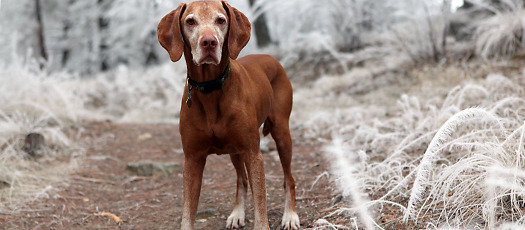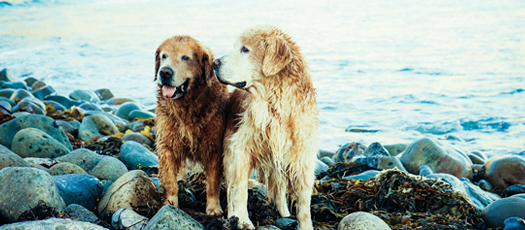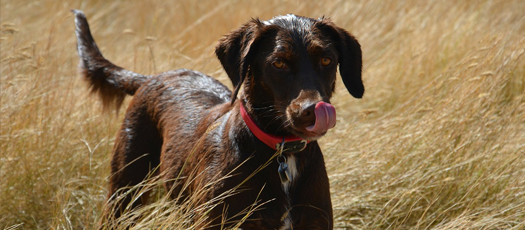
Ways to support your older dog in everyday life and delay the aging process
It is only natural for our dogs to grow older. But there are a few ways to support your beloved canine companion in everyday life and delay the aging process. They make our graying friends’ lives more pleasant and easier – and enhance quality of life.
This article presents several suggestions. Although comfort and well-being are always individual matters, I’m sure your furry friend will very much appreciate many of these ideas as needed. And when it comes to creativity, the sky’s the limit. All you need to do is observe your dog closely.
Special tip: Some of these tips can also come in handy if your dog is still on the younger side and in the case of joint problems.
Avoid excessive weight – it significantly shortens lifespans!
Let’s start with a point that is important to your dog over its entire life and has a big impact on its lifespan. A healthy body weight has a big influence on a dog’s health and the aging process. The closer your dog is to its optimum weight, the more easily it can move and the more pleasure it will take in doing so. If your dog is overweight, a serious health risk arises. Life expectancy for overweight dogs is drastically reduced, by as much as 20 percent. As you can see, excess weight can harm your dog over its entire lifetime.
If your dog is overweight, a vicious cycle sets in. The dog takes less pleasure in physical activity, because each step is harder. The entire musculoskeletal system is overloaded, and the joints suffer lasting damage. Overall cardiovascular health also declines. Physical activity becomes an effort, and as activity levels decrease, the dog uses less energy, which causes further weight gain. In addition, the risk of diseases like diabetes, heart conditions, and tumors rises.
Appropriate physical activity for older dogs – “a rolling stone gathers no moss”
Even older dogs need physical activity, but you should be sure to structure it differently. If your dog doesn’t get any physical activity, it will lose strength and muscle tone and age faster. This is something you can see in people, too: Older people who have been active all their lives and make sure to get regular exercise even at advanced ages stay fit and mobile for longer and get sick less often. Proper activity is one way to have a positive influence on the emergence and progress of diseases like arthritis and spondylosis. It also helps preserve your dog’s muscle tone and maintain mobility. The cardiovascular system also needs physical activity. The only exception is if your dog has received strict orders to rest. Still, it is normal for the body to tire faster with advancing age and to take longer to recover. Cardiovascular endurance and muscle strength and tone also diminish. The joints begin to suffer from arthritis here and there, and the muscles grow weaker. If we insist that our furry friend stay as active now as it did during the rest of its adulthood, we are asking too much of it. The dog’s joints, overwhelmed by this activity, begin to ache, and its muscles are tense. The heart is asked to do more than it can. Your dog gets exhausted, having worn itself out.
How do I get my older dog to be physically active without overdoing it?
You should make sure your dog’s activity levels are geared toward its age and health condition. Variety is another important part of this.
I recommend taking several short walks with it instead of two long ones, for example. Consistent activity is good for your dog, and the recovery phases after each walk become much shorter. In short, your dog will be less exhausted and can spend its energy more efficiently. All that has a positive impact on the dog’s lifespan.
Special tip: When going for walks in the fall and winter, your senior dog will really benefit from a jacket or sweater to keep it warm.
Regular “gymnastics” – a little extra physical activity with a big impact
Regular, targeted exercises can help keep your older dog fit and significantly slow the aging process. These can be simple, everyday motions like giving a paw or going from standing to sitting or from standing to down, which you do regularly with your dog. Doing this will train the dog’s mobility and musculature and maintain stable coordination, balance and body awareness at the same time. Regular training is also mentally stimulating.
When movement is harder and support is needed
It’s not unusual for everyday movements that used to be completely normal to simply be very difficult, and for a dog to feel unsure about them. Various aids have been developed for this in recent years. Here are a few of my suggestions.
Carriers for the stairs – climb stairs with confidence
Many older dogs have a really hard time climbing stairs. Some are easy to simply carry upstairs, but that is harder with dogs of a certain size. Special carriers have been developed for this very situation, giving you a great way to help your dog get up the stairs. There are carriers to support just the front or hind legs, and some that lift the entire dog. These carriers are also very useful if your dog has a hard time standing up or needs help and a bit of stability when walking.
When choosing a carrier, be sure it fits comfortably and securely and is made of a tear-resistant, sturdy material. The material should also be soft and not press or pinch uncomfortably anywhere. Neoprene is often used for these carriers. It is also easy to clean and dries quickly.
Dog ramps for your car – prevent falls and injuries
If you notice your dog standing in front of the trunk of your car, hesitantly shifting from one paw to the other instead of leaping into the car with gusto, it’s definitely time to give it some help getting in and out of the car. You can always lift your dog into the car, of course. Depending on its size, though, it may be more pleasant for both sides to use a ramp instead. Always be sure the ramp is wide enough for your dog and that it is not too steep and offers a non-slip surface. I also recommend that you always stay next to your dog when it uses the ramp, so you can help if it loses its balance. A dog ramp gives your older dog a way to get into and out of a car securely.
Protection for paws and nails – better grip indoors and out
Many people still find dog shoes and paw protectors funny or cute to look at. But they aren’t a fashion accessory; for some dogs, they are essential. For dogs that can no longer grip properly on slick or smooth floors, for example, they can prevent slips and falls. They also protect the paws and nails of dogs that drag their feet. I recommend always making sure the shoes are a perfect fit. They should not be too tight, but they also shouldn’t slide around. There are shoes specially designed for use indoors, and there are also specific outdoor shoes made of different materials, with soles equipped with a different tread.
Bandages and braces
Bandages or braces give your dog stability. They can support and take some of the weight off of the dog’s joints. The ligaments and tendons grow weaker as a dog ages. Many dogs tend to hyperextend when this happens. In these cases, using a bandage or brace to support and guide the joint can be a big help. I recommend consulting a physical therapist or orthopedic technician for individual advice on selecting the right option for your dog.
Elevated place for water and food
Especially for larger dogs, lifting the place where water and food are located is a good way to reduce strain at advanced age, since your dog won’t have to bend too far forward. Having food and water positioned higher means the strain on the joints is evenly distributed, and the dog can eat in a comfortable position.
A healthy diet and healthy sleep
Be sure to feed your dog a balanced, healthy diet that is as appropriate to the species as possible. A healthy diet not only affects a dog’s well-being in the here and now, but also has long-term effects on its health and the aging process. There are also many different nutritional supplements you can use to support your dog as it grows older. In addition to a healthy diet, healthy sleep is also important. Dogs sleep anywhere from 17 to 20 hours a day, and the amount of sleep they need grows as they get older. Make sure your dog has a good, comfortable place to lie down so that it can really relax and recover during sleep and its joints and spine are well positioned in a way that relieves pressure.
Summary – how to make your senior dog’s life easier
As you see, there are a wealth of simple things you can easily do in your day-to-day life to make your dog’s life easier as it ages. Some of them also have positive effects on the dog’s aging process. The important thing is for your beloved furry friend to keep active as it grows older – with help – and not be pushed to the sidelines.


